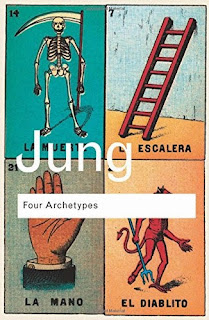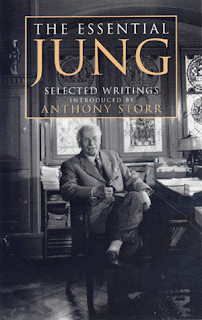 |
| “We cannot change anything unless we accept it.” ― C.G. Jung, Modern Man in Search of a Soul |
•
‘I can understand myself only in the light of inner happenings. It is these that make up the singularity of my life, and with these my autobiography deals’ – Carl Gustav Jung.
In 1957, four years before his death, Carl Gustav Jung began writing his life story. But what began as an exercise in autobiography soon morphed into an altogether more profound undertaking. The result is an absorbing piece of self-analysis: a frank statement of faith, philosophy and principles from one of the great explorers of the human mind.
Covering everything from Sigmund Freud, analytical psychology and Jungian dream interpretation to a forthright discussion of Christianity and the existence of God, these final reflections on an extraordinary life are a fitting coda to the work of Carl Gustav Jung.
Ebook Preview/Excerpts ~ Memories, Dreams, Reflections
•
Man and His Symbols is the last work undertaken by Carl Jung before his death in 1961. First published in 1964, it is divided into five parts, four of which were written by associates of Jung: Marie-Louise von Franz, Joseph L. Henderson, Aniela Jaffé, and Jolande Jacobi. The book, which contains numerous illustrations, seeks to provide a clear explanation of Jung's complex theories for a wide non-specialist readership.
Ebook Preview/Excerpts ~ Man and His Symbols
•
While Jung considered The Red Book to be his most important work, only a handful of people have ever seen it. Now, in a complete facsimile and translation, it is available to scholars and the general public. It is an astonishing example of calligraphy and art on a par with The Book of Kells and the illuminated manuscripts of William Blake. This publication of The Red Book is a watershed that will cast new light on the making of modern psychology.
Ebook Preview/Excerpts ~ The Red Book
•
The concept of the archetype is crucial to Jung's radical interpretation of the human mind. Jung believed that every person partakes of a universal or collective unconscious that persists through generations. The origins of the concept can be traced to his very first publication in 1902 and it remained central to his thought throughout his life. As well as explaining the theoretical background behind the idea, in Four Archetypes Jung describes the four archetypes that he considers fundamental to the psychological make-up of every individual: mother, rebirth, spirit and trickster. Exploring their role in myth, fairytale and scripture, Jung engages the reader in discoveries that challenge and enlighten the ways we perceive ourselves and others.
Ebook Preview/Excerpts ~ Four Archetypes
•
Modern Man in Search of a Soul is the perfect introduction to the theories and concepts of one of the most original and influential religious thinkers of the twentieth century. Lively and insightful, it covers all of his most significant themes, including man's need for a God and the mechanics of dream analysis. One of his most famous books, it perfectly captures the feelings of confusion that many sense today. Generation X might be a recent concept, but Jung spotted its forerunner over half a century ago. For anyone seeking meaning in today's world, Modern Man in Search of a Soul is a must.
Ebook Preview/Excerpts ~ Modern Man in Search of a Soul
•
These two essays, written late in Jung's life, reflect his responses to the shattering experience of World War II and the dawn of mass society. Among his most influential works, "The Undiscovered Self" is a plea for his generation--and those to come--to continue the individual work of self-discovery and not abandon needed psychological reflection for the easy ephemera of mass culture. Only individual awareness of both the conscious and unconscious aspects of the human psyche, Jung tells us, will allow the great work of human culture to continue and thrive.
Jung's reflections on self-knowledge and the exploration of the unconscious carry over into the second essay, "Symbols and the Interpretation of Dreams," completed shortly before his death in 1961. Describing dreams as communications from the unconscious, Jung explains how the symbols that occur in dreams compensate for repressed emotions and intuitions. This essay brings together Jung's fully evolved thoughts on the analysis of dreams and the healing of the rift between consciousness and the unconscious, ideas that are central to his system of psychology.
Ebook Preview/Excerpts ~ The Undiscovered Self
•
The concept of 'Archteypes' and the hypothesis of 'A Collective
Unconscious' are two of Jung's better known and most exciting ideas. In
this volume - taken from the Collected Works and appearing in paperback
for the first time - Jung describes and elaborates the two concepts.
Three essays establish the theoretical basis which are then followed by essays on specific archetypes. The relation of these to the process of individuation is examined in the last section. The Archetypes and the Collective Unconscious is one of Jung's central works. There are many illustrations in full colour.
Three essays establish the theoretical basis which are then followed by essays on specific archetypes. The relation of these to the process of individuation is examined in the last section. The Archetypes and the Collective Unconscious is one of Jung's central works. There are many illustrations in full colour.
Ebook Preview/Excerpts ~ The Archetypes and the Collective Unconscious
•
Psychological Types
Psychological Types is one of Jung's most important and most famous works. First published by Routledge (Kegan Paul) in the early 1920s it appeared after Jung's so-called fallow period, during which he published little, and it is perhaps the first significant book to appear after his own confrontation with the unconscious. It is the book that introduced the world to the terms 'extravert' and 'introvert'.
Though very much associated with the unconscious, in Psychological Types Jung shows himself to be a supreme theorist of the conscious. In putting forward his system of psychological types Jung provides a means for understanding ourselves and the world around us: our different patterns of behaviour, our relationships, marriage, national and international conflict, organizational functioning.
Appearing in paperback for the first time this central volume from Jung's Collected Works will be essential to anyone requiring a proper understanding of Jung's psychology.
•
This volume presents the essentials of Jung's thought in his own words. To familiarize readers with the ideas for which Jung is best known, the British psychiatrist and writer Anthony Storr has selected extracts from Jung's writings that pinpoint his many original contributions and relate the development of his thought to his biography. Dr. Storr has prefaced each extract with explanatory notes. These notes link the extracts, and with Dr. Storr's introduction, they show the progress and coherence of Jung's ideas, including such concepts as the collective unconscious, the archetypes, introversion and extroversion, individuation, and Jung's view of integration as the goal of the development of the personality.
Ebook Preview/Excerpts ~ The Essential Jung
•
The Red Book: A Reader's Edition
The Red Book: A Reader’s Edition features Sonu Shamdasani’s introductory essay and the full translation of Jung’s vital work in one volume.
As Sara Corbett wrote in the New York Times, “The creation of one of modern history’s true visionaries, The Red Book is a singular work, outside of categorization. As an inquiry into what it means to be human, it transcends the history of psychoanalysis and underscores Jung’s place among revolutionary thinkers like Marx, Orwell and, of course, Freud.”
See also C.G. Jung - Quotes here & Free Book Excerpts here.











